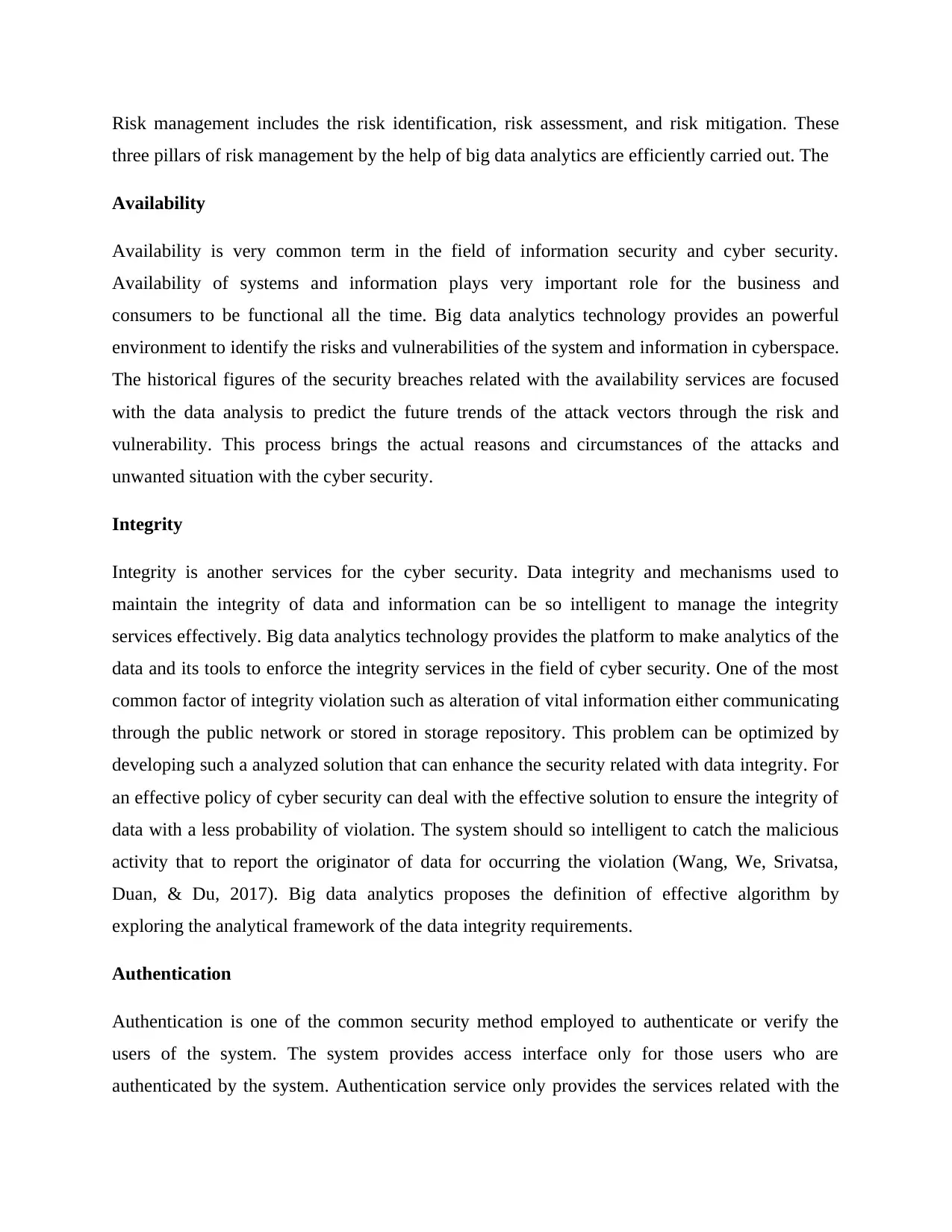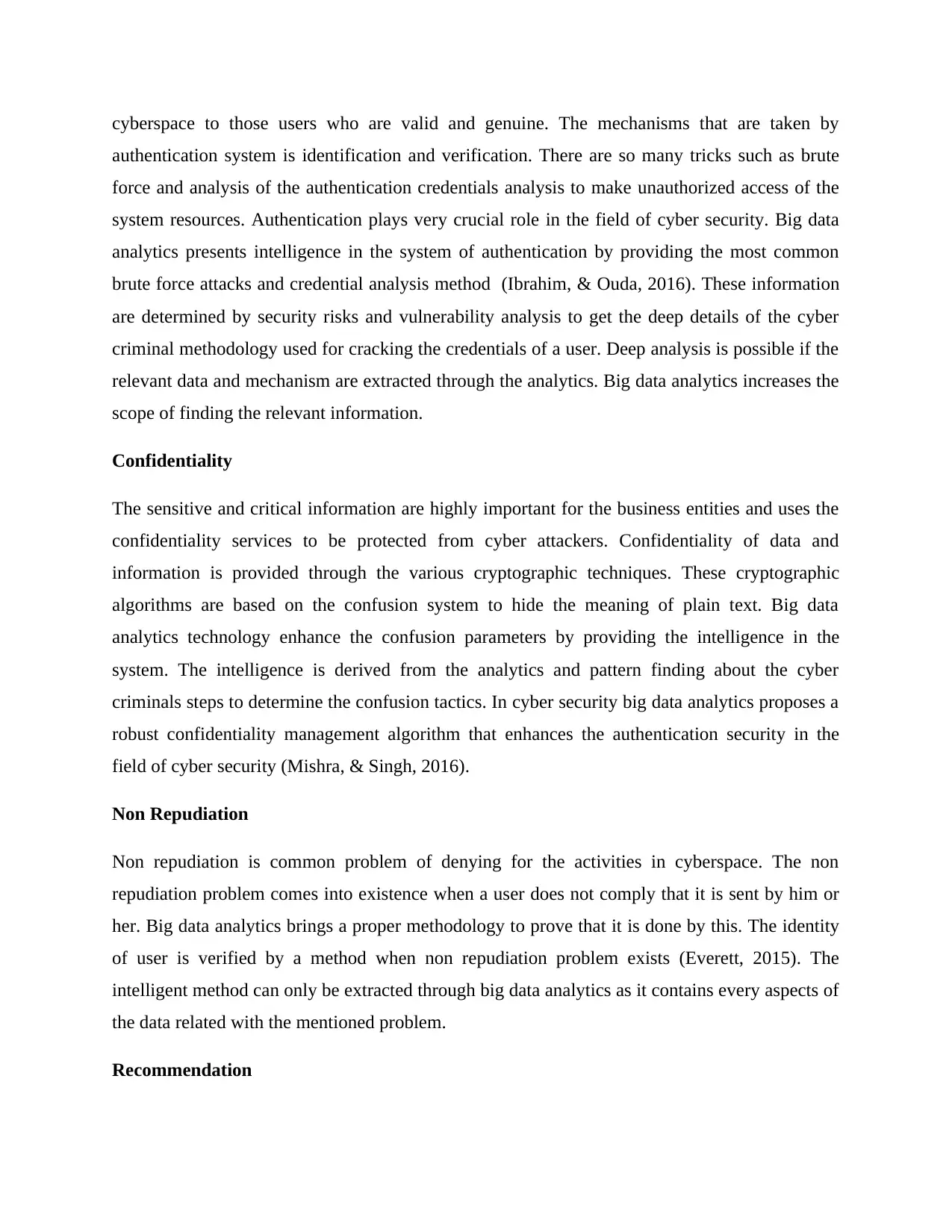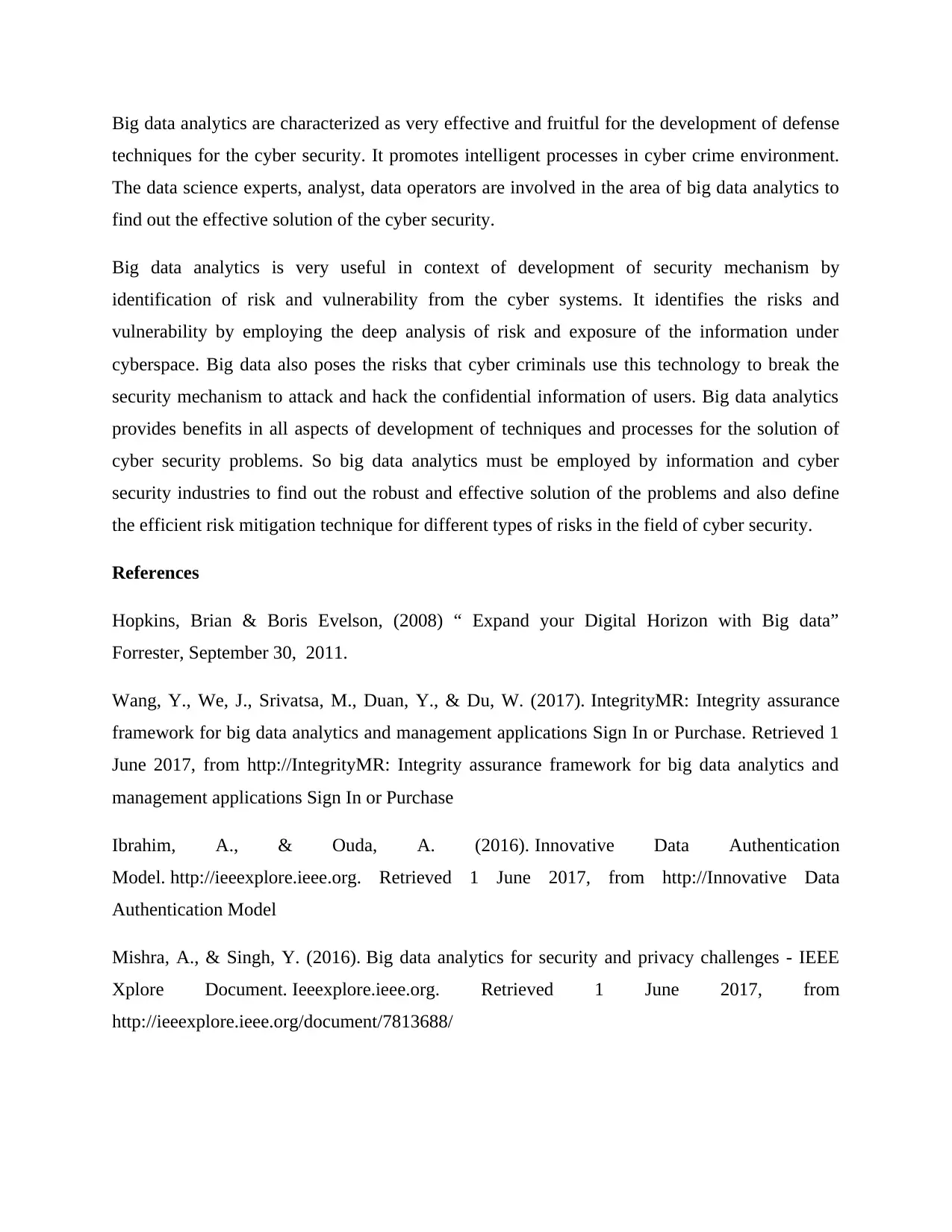Big Data Analytics in Cybersecurity
VerifiedAdded on 2019/09/23
|5
|1514
|180
Report
AI Summary
This report examines the application of big data analytics in bolstering cybersecurity defenses. It begins by defining big data and its relevance to the security industry, highlighting its potential to improve risk management and create more effective solutions for cybersecurity threats. The report then delves into the five pillars of information assurance—availability, integrity, authentication, confidentiality, and non-repudiation—explaining how big data analytics contributes to each. For example, it discusses how big data analytics aids in identifying vulnerabilities related to system availability, improving data integrity through intelligent analysis, enhancing authentication mechanisms by detecting common attack vectors, and strengthening confidentiality through advanced cryptographic techniques. The report also addresses the challenge of non-repudiation, demonstrating how big data analytics can provide robust methods for verifying user actions. Finally, the report concludes by recommending the widespread adoption of big data analytics within the cybersecurity industry to develop more robust and effective solutions for mitigating various cybersecurity risks.

Big Data Analytics
Introduction
Big data analytics is buzzword for the security industries to innovate and develop the robust and
intelligent defensive solution for the cyber security. Big data is defined as the data having the
properties of velocity, veracity, variety. Big data is generated in millions of bytes per second so
that it contains every piece of information. Big data analytics is showing the abundant scope to
improve the cyber security. The data analyst of the industries gains the confidence by big data
analytics to develop more effective solution for the security risks and problems. There is need of
the risk management and intelligent action oriented technique to provide the accurate and timely
solution for the security issues and the problems associated with the cyberspace. The risk
management and assessment by big data analytic become more proper and accurate. This core
benefit of this technology boosts the security industries to adopt this technology to develop more
robust and cost effective solutions for securing the assets of the information system of an
organization. The competitive environment of the innovation and development of the latest tools
and technology are more powerful for the identification, assessment and defining the core
security system with planned feasibility (Hopkins, Brian & Boris Evelson, 2008).
There are so many positive and negative implications of the selected technology such as big data
analytics upon the cyber security. The security experts states that the big data analytics can be
used to develop robust and efficient security systems. These experts also states that the cyber
criminals may use this technology to find out the attack mechanism to break any incorporated
security defensive mechanism.
Big Data Analytics and Five Pillars of Information Assurance
The five pillars of information assurance in the cyberspace of an information system and Its
users are availability, integrity, authentication, confidentiality and non repudiation. These all are
the security and privacy systems requires to be addressed by robust security analysis platform to
determine the effective solution of any circumstance of the security breaches and categorized
cyber attacks.
Introduction
Big data analytics is buzzword for the security industries to innovate and develop the robust and
intelligent defensive solution for the cyber security. Big data is defined as the data having the
properties of velocity, veracity, variety. Big data is generated in millions of bytes per second so
that it contains every piece of information. Big data analytics is showing the abundant scope to
improve the cyber security. The data analyst of the industries gains the confidence by big data
analytics to develop more effective solution for the security risks and problems. There is need of
the risk management and intelligent action oriented technique to provide the accurate and timely
solution for the security issues and the problems associated with the cyberspace. The risk
management and assessment by big data analytic become more proper and accurate. This core
benefit of this technology boosts the security industries to adopt this technology to develop more
robust and cost effective solutions for securing the assets of the information system of an
organization. The competitive environment of the innovation and development of the latest tools
and technology are more powerful for the identification, assessment and defining the core
security system with planned feasibility (Hopkins, Brian & Boris Evelson, 2008).
There are so many positive and negative implications of the selected technology such as big data
analytics upon the cyber security. The security experts states that the big data analytics can be
used to develop robust and efficient security systems. These experts also states that the cyber
criminals may use this technology to find out the attack mechanism to break any incorporated
security defensive mechanism.
Big Data Analytics and Five Pillars of Information Assurance
The five pillars of information assurance in the cyberspace of an information system and Its
users are availability, integrity, authentication, confidentiality and non repudiation. These all are
the security and privacy systems requires to be addressed by robust security analysis platform to
determine the effective solution of any circumstance of the security breaches and categorized
cyber attacks.
Paraphrase This Document
Need a fresh take? Get an instant paraphrase of this document with our AI Paraphraser

Risk management includes the risk identification, risk assessment, and risk mitigation. These
three pillars of risk management by the help of big data analytics are efficiently carried out. The
Availability
Availability is very common term in the field of information security and cyber security.
Availability of systems and information plays very important role for the business and
consumers to be functional all the time. Big data analytics technology provides an powerful
environment to identify the risks and vulnerabilities of the system and information in cyberspace.
The historical figures of the security breaches related with the availability services are focused
with the data analysis to predict the future trends of the attack vectors through the risk and
vulnerability. This process brings the actual reasons and circumstances of the attacks and
unwanted situation with the cyber security.
Integrity
Integrity is another services for the cyber security. Data integrity and mechanisms used to
maintain the integrity of data and information can be so intelligent to manage the integrity
services effectively. Big data analytics technology provides the platform to make analytics of the
data and its tools to enforce the integrity services in the field of cyber security. One of the most
common factor of integrity violation such as alteration of vital information either communicating
through the public network or stored in storage repository. This problem can be optimized by
developing such a analyzed solution that can enhance the security related with data integrity. For
an effective policy of cyber security can deal with the effective solution to ensure the integrity of
data with a less probability of violation. The system should so intelligent to catch the malicious
activity that to report the originator of data for occurring the violation (Wang, We, Srivatsa,
Duan, & Du, 2017). Big data analytics proposes the definition of effective algorithm by
exploring the analytical framework of the data integrity requirements.
Authentication
Authentication is one of the common security method employed to authenticate or verify the
users of the system. The system provides access interface only for those users who are
authenticated by the system. Authentication service only provides the services related with the
three pillars of risk management by the help of big data analytics are efficiently carried out. The
Availability
Availability is very common term in the field of information security and cyber security.
Availability of systems and information plays very important role for the business and
consumers to be functional all the time. Big data analytics technology provides an powerful
environment to identify the risks and vulnerabilities of the system and information in cyberspace.
The historical figures of the security breaches related with the availability services are focused
with the data analysis to predict the future trends of the attack vectors through the risk and
vulnerability. This process brings the actual reasons and circumstances of the attacks and
unwanted situation with the cyber security.
Integrity
Integrity is another services for the cyber security. Data integrity and mechanisms used to
maintain the integrity of data and information can be so intelligent to manage the integrity
services effectively. Big data analytics technology provides the platform to make analytics of the
data and its tools to enforce the integrity services in the field of cyber security. One of the most
common factor of integrity violation such as alteration of vital information either communicating
through the public network or stored in storage repository. This problem can be optimized by
developing such a analyzed solution that can enhance the security related with data integrity. For
an effective policy of cyber security can deal with the effective solution to ensure the integrity of
data with a less probability of violation. The system should so intelligent to catch the malicious
activity that to report the originator of data for occurring the violation (Wang, We, Srivatsa,
Duan, & Du, 2017). Big data analytics proposes the definition of effective algorithm by
exploring the analytical framework of the data integrity requirements.
Authentication
Authentication is one of the common security method employed to authenticate or verify the
users of the system. The system provides access interface only for those users who are
authenticated by the system. Authentication service only provides the services related with the

cyberspace to those users who are valid and genuine. The mechanisms that are taken by
authentication system is identification and verification. There are so many tricks such as brute
force and analysis of the authentication credentials analysis to make unauthorized access of the
system resources. Authentication plays very crucial role in the field of cyber security. Big data
analytics presents intelligence in the system of authentication by providing the most common
brute force attacks and credential analysis method (Ibrahim, & Ouda, 2016). These information
are determined by security risks and vulnerability analysis to get the deep details of the cyber
criminal methodology used for cracking the credentials of a user. Deep analysis is possible if the
relevant data and mechanism are extracted through the analytics. Big data analytics increases the
scope of finding the relevant information.
Confidentiality
The sensitive and critical information are highly important for the business entities and uses the
confidentiality services to be protected from cyber attackers. Confidentiality of data and
information is provided through the various cryptographic techniques. These cryptographic
algorithms are based on the confusion system to hide the meaning of plain text. Big data
analytics technology enhance the confusion parameters by providing the intelligence in the
system. The intelligence is derived from the analytics and pattern finding about the cyber
criminals steps to determine the confusion tactics. In cyber security big data analytics proposes a
robust confidentiality management algorithm that enhances the authentication security in the
field of cyber security (Mishra, & Singh, 2016).
Non Repudiation
Non repudiation is common problem of denying for the activities in cyberspace. The non
repudiation problem comes into existence when a user does not comply that it is sent by him or
her. Big data analytics brings a proper methodology to prove that it is done by this. The identity
of user is verified by a method when non repudiation problem exists (Everett, 2015). The
intelligent method can only be extracted through big data analytics as it contains every aspects of
the data related with the mentioned problem.
Recommendation
authentication system is identification and verification. There are so many tricks such as brute
force and analysis of the authentication credentials analysis to make unauthorized access of the
system resources. Authentication plays very crucial role in the field of cyber security. Big data
analytics presents intelligence in the system of authentication by providing the most common
brute force attacks and credential analysis method (Ibrahim, & Ouda, 2016). These information
are determined by security risks and vulnerability analysis to get the deep details of the cyber
criminal methodology used for cracking the credentials of a user. Deep analysis is possible if the
relevant data and mechanism are extracted through the analytics. Big data analytics increases the
scope of finding the relevant information.
Confidentiality
The sensitive and critical information are highly important for the business entities and uses the
confidentiality services to be protected from cyber attackers. Confidentiality of data and
information is provided through the various cryptographic techniques. These cryptographic
algorithms are based on the confusion system to hide the meaning of plain text. Big data
analytics technology enhance the confusion parameters by providing the intelligence in the
system. The intelligence is derived from the analytics and pattern finding about the cyber
criminals steps to determine the confusion tactics. In cyber security big data analytics proposes a
robust confidentiality management algorithm that enhances the authentication security in the
field of cyber security (Mishra, & Singh, 2016).
Non Repudiation
Non repudiation is common problem of denying for the activities in cyberspace. The non
repudiation problem comes into existence when a user does not comply that it is sent by him or
her. Big data analytics brings a proper methodology to prove that it is done by this. The identity
of user is verified by a method when non repudiation problem exists (Everett, 2015). The
intelligent method can only be extracted through big data analytics as it contains every aspects of
the data related with the mentioned problem.
Recommendation
⊘ This is a preview!⊘
Do you want full access?
Subscribe today to unlock all pages.

Trusted by 1+ million students worldwide

Big data analytics are characterized as very effective and fruitful for the development of defense
techniques for the cyber security. It promotes intelligent processes in cyber crime environment.
The data science experts, analyst, data operators are involved in the area of big data analytics to
find out the effective solution of the cyber security.
Big data analytics is very useful in context of development of security mechanism by
identification of risk and vulnerability from the cyber systems. It identifies the risks and
vulnerability by employing the deep analysis of risk and exposure of the information under
cyberspace. Big data also poses the risks that cyber criminals use this technology to break the
security mechanism to attack and hack the confidential information of users. Big data analytics
provides benefits in all aspects of development of techniques and processes for the solution of
cyber security problems. So big data analytics must be employed by information and cyber
security industries to find out the robust and effective solution of the problems and also define
the efficient risk mitigation technique for different types of risks in the field of cyber security.
References
Hopkins, Brian & Boris Evelson, (2008) “ Expand your Digital Horizon with Big data”
Forrester, September 30, 2011.
Wang, Y., We, J., Srivatsa, M., Duan, Y., & Du, W. (2017). IntegrityMR: Integrity assurance
framework for big data analytics and management applications Sign In or Purchase. Retrieved 1
June 2017, from http://IntegrityMR: Integrity assurance framework for big data analytics and
management applications Sign In or Purchase
Ibrahim, A., & Ouda, A. (2016). Innovative Data Authentication
Model. http://ieeexplore.ieee.org. Retrieved 1 June 2017, from http://Innovative Data
Authentication Model
Mishra, A., & Singh, Y. (2016). Big data analytics for security and privacy challenges - IEEE
Xplore Document. Ieeexplore.ieee.org. Retrieved 1 June 2017, from
http://ieeexplore.ieee.org/document/7813688/
techniques for the cyber security. It promotes intelligent processes in cyber crime environment.
The data science experts, analyst, data operators are involved in the area of big data analytics to
find out the effective solution of the cyber security.
Big data analytics is very useful in context of development of security mechanism by
identification of risk and vulnerability from the cyber systems. It identifies the risks and
vulnerability by employing the deep analysis of risk and exposure of the information under
cyberspace. Big data also poses the risks that cyber criminals use this technology to break the
security mechanism to attack and hack the confidential information of users. Big data analytics
provides benefits in all aspects of development of techniques and processes for the solution of
cyber security problems. So big data analytics must be employed by information and cyber
security industries to find out the robust and effective solution of the problems and also define
the efficient risk mitigation technique for different types of risks in the field of cyber security.
References
Hopkins, Brian & Boris Evelson, (2008) “ Expand your Digital Horizon with Big data”
Forrester, September 30, 2011.
Wang, Y., We, J., Srivatsa, M., Duan, Y., & Du, W. (2017). IntegrityMR: Integrity assurance
framework for big data analytics and management applications Sign In or Purchase. Retrieved 1
June 2017, from http://IntegrityMR: Integrity assurance framework for big data analytics and
management applications Sign In or Purchase
Ibrahim, A., & Ouda, A. (2016). Innovative Data Authentication
Model. http://ieeexplore.ieee.org. Retrieved 1 June 2017, from http://Innovative Data
Authentication Model
Mishra, A., & Singh, Y. (2016). Big data analytics for security and privacy challenges - IEEE
Xplore Document. Ieeexplore.ieee.org. Retrieved 1 June 2017, from
http://ieeexplore.ieee.org/document/7813688/
Paraphrase This Document
Need a fresh take? Get an instant paraphrase of this document with our AI Paraphraser

Everett, C. (2015). Big data – the future of cyber-security or its latest threat?. Computer Fraud &
Security, 2015(9), 14-17. http://dx.doi.org/10.1016/s1361-3723(15)30085-3
Security, 2015(9), 14-17. http://dx.doi.org/10.1016/s1361-3723(15)30085-3
1 out of 5
Related Documents
Your All-in-One AI-Powered Toolkit for Academic Success.
+13062052269
info@desklib.com
Available 24*7 on WhatsApp / Email
![[object Object]](/_next/static/media/star-bottom.7253800d.svg)
Unlock your academic potential
Copyright © 2020–2025 A2Z Services. All Rights Reserved. Developed and managed by ZUCOL.





